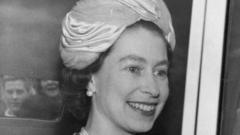In 1964, Anthony Blunt, who oversaw the Royal Art Collection, admitted his role as a Soviet spy dating back to the 1930s. Yet, the Queen only learned the full extent of this information in the 1970s. According to reported details, her reaction was notably composed, indicating she had been aware of suspicion surrounding Blunt since the earlier exposure of fellow spies Guy Burgess and Donald Maclean.
The decision to formally inform the monarch was influenced by fears that information regarding Blunt’s espionage could emerge publicly following his ill health, which ultimately led to his death in 1983. The files detail how MI5 conducted numerous interviews with Blunt after suspicion initially fell on him in the early 1950s, though they only began to unravel the truth with his candid acknowledgment.
The Queen's private secretary briefly informed her of Blunt's potential involvement in espionage matters, but it was decided that only when the threat of media scrutiny increased would she be fully briefed. Ultimately, in 1979, Prime Minister Margaret Thatcher brought the scandal to public attention, confirming Blunt's actions had ties to Russian intelligence.
The correspondence and presentation of these files also serve as reminders of the complex relationship between government secrets and monarchy, and how perception and reality can be vastly different in the realm of national security. Further documents released by MI5 highlight broader espionage issues of the time, contributing to an understanding of the intricate spy network that has historically shaped British political and social landscapes.
Blunt's legacy remains controversial, marked by his betrayal of trust and the significant political implications of espionage during the Cold War era, all underscored by the Queen's calm response to a deeply unsettling truth.
The decision to formally inform the monarch was influenced by fears that information regarding Blunt’s espionage could emerge publicly following his ill health, which ultimately led to his death in 1983. The files detail how MI5 conducted numerous interviews with Blunt after suspicion initially fell on him in the early 1950s, though they only began to unravel the truth with his candid acknowledgment.
The Queen's private secretary briefly informed her of Blunt's potential involvement in espionage matters, but it was decided that only when the threat of media scrutiny increased would she be fully briefed. Ultimately, in 1979, Prime Minister Margaret Thatcher brought the scandal to public attention, confirming Blunt's actions had ties to Russian intelligence.
The correspondence and presentation of these files also serve as reminders of the complex relationship between government secrets and monarchy, and how perception and reality can be vastly different in the realm of national security. Further documents released by MI5 highlight broader espionage issues of the time, contributing to an understanding of the intricate spy network that has historically shaped British political and social landscapes.
Blunt's legacy remains controversial, marked by his betrayal of trust and the significant political implications of espionage during the Cold War era, all underscored by the Queen's calm response to a deeply unsettling truth.



















